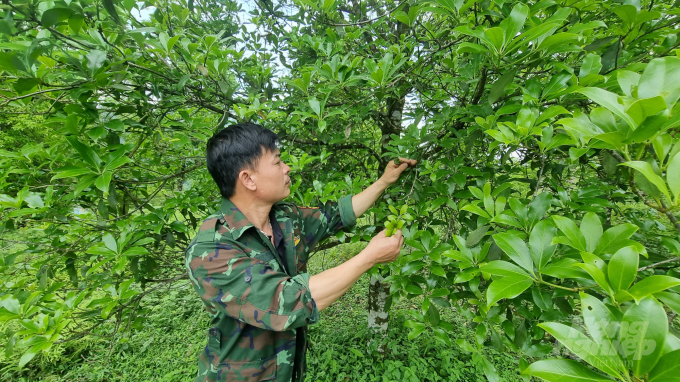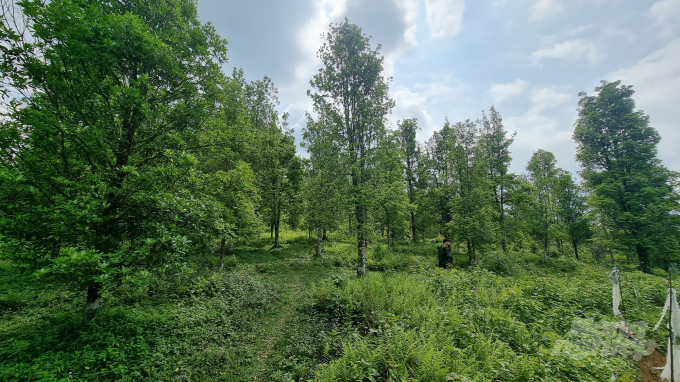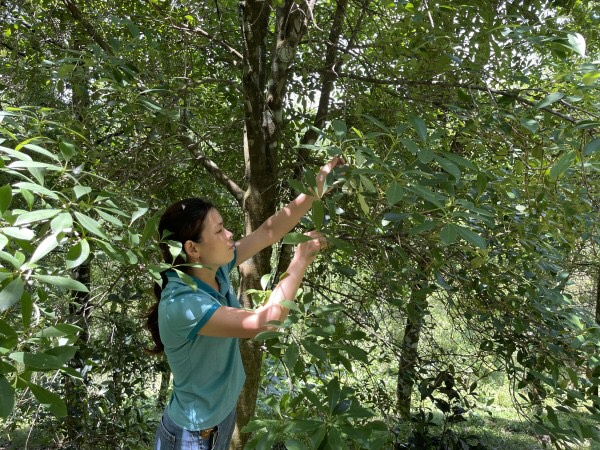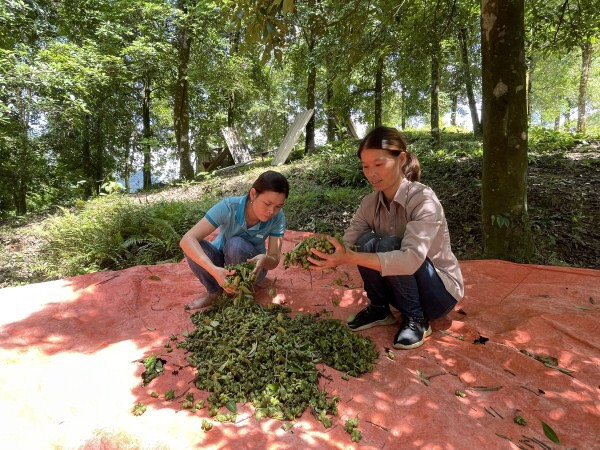May 31, 2025 | 20:53 GMT +7
May 31, 2025 | 20:53 GMT +7
Hotline: 0913.378.918
May 31, 2025 | 20:53 GMT +7
Hotline: 0913.378.918
Anise trees have been grown scatteredly in many localities of Cao Bang province in the past. But it was not until the early 1990s that anise trees were introduced to the districts of Tra Linh (now merged into Trung Khanh district), Thach An, Bao Lac, Bao Lam following the PAM afforestation projects as well as 30a, 135 programs.
We visited formerly Tra Linh district, now merged into Trung Khanh district in Cao Chuong commune, one of the regions with the largest and oldest anise planting area in Cao Bang province.

The canopy of anise trees is quite thick and wide, The trees serve as a valuable income source from flowers, as well as significantly improve forest cover and quality. Photo: Cong Hai.
Mr. La Van Canh in Doong Giai hamlet, former chairman of Cao Chuong commune shared: In the past, a lot of hilly land and forest land were vacant. When the program of land and forest allocation was implemented, each household is assigned 3 to 4 hectares of forest, some are allocated 7 to 8 hectares. In the early 1990s, the State supported afforestation seedlings, including anise under the PAM program. Anise was most popularly grown from 1997 to 2000.
However, most farmers at the time did not know how to plant anise properly, either too densely or too sparsely planted. In addition, the value of star anise 20 years ago was not high; so farmers only considered anise as a forest tree to cover bare hilly land and gave it little care.
Mr. Thang Van An, Chairman of Cao Chuong Communal People's Committee said: After realizing that anise is a tree with high economic efficiency suitable for the local climate and soil conditions, the local government has put anise into the communal economic development strategy as well as orient the tree to become a key crop in poverty reduction.
The commune has coordinated with the district through programs and projects to invest in seedlings, provide technical guidance on how to plant and care for anise, propagate and mobilize farmers to expand anise planting area.

Thanks to proper planting and care, anise forest in Doong Giai hamlet, Cao Chuong commune, Trung Khanh district has developed very strongly. Photo: Toan Nguyen.
Most of the hamlets in the commune currently have anise planting areas, but they are concentrated in Ban Pat, Doong Gioi, Tai Nam, Tan Lap, Son Lo hamlets with a total area of over 600 hectares, nearly 500 hectares of which give an average yield of 3 - 4 tons/hectares, an average output of 1,300 - 1,500 tons of fresh anise. The total annual income from anise of the commune is 30 - 40 billion VND.
Mr. Ha Minh Hai, Head of Trung Khanh district Department of Agriculture and Rural Development said: Anise is one of the district's main crops. When the price of anise increased and stabilized in recent years, farmers have become aware of the public investment in caring and fertilizing anise trees to develop strongly until harvest.
The area of anise trees grown in the district has reached over 1,000 hectares, 90% of which is being harvested. The average annual output of fresh anise in the district is in the range of 2,500 - 3,000 tons, mainly in Cao Chuong, Xuan Noi communes and Tra Linh township.
Anise brings an annual average total income of 50-70 billion VND for farmers. After growing anise, many households have an average income of 20 - 30 million VND/year, many households even reached an income of 100-200 million VND/year. Anise has really brought in fortune, changing the lives of many households in Trung Khanh district.
Every year, the district cooperates with the Quy Son River Protection Forest Management Board to replace old, low-yield anise areas. Trung Khanh district also support farmers with seedlings and fertilizers from many sources to expand the anise planting area.
Thach An is a rapidly developing district with the largest anise area in Cao Bang province. The district currently has 2,560 ha of anise, concentrated in Van Trinh, Duc Xuan, Le Lai, Thuy Hung, Duc Long, Quang Trong communes and Dong Khe town.

Anise is currently the main source of income for farmers in the highlands of Cao Bang province, many regions grew rich thanks to this tree. Photo: Cong Hai.
After the 2021 crop, Mr. Hoang Van Sien in Lung Man hamlet, Van Trinh commune had a great harvest. Over 4 hectares of anise brings him an income of nearly 200 million VND thanks to the high and stable prices throughout the main and off-season.
Mr. Sien excitedly confided: "Thanks to anise, my family's life has changed significantly. From a small initial area, the land for growing anise has reached 4 hectares, 3 hectares of which used for harvesting has brought an average income from 80 to 100 million VND/year. Thanks to anise, my family was able to build a house, and a better life.
Growing anise is quite simple: the tree only requires care and protection when it is young; When the tree has grown taller than 1m, it does not need much care and pest control compared to other crops, but the economic efficiency is relatively stable with long-term harvest. The anise tree blooms twice consecutively each year.
The first flower blooms from the end of June to the end of July, called the quarter flower and the next harvest is from December to February of the following year. The second wave of flowers blooms immediately after the first, around August - September, called a seasonal harvest. Farmers in the commune mainly sell freshly harvested anise to small traders from Cao Bang and Lang Son cities.

The current market for star anise is very favorable. Photo: TN.
"The price of star anise in recent years is quite high. The average price of fresh star anise is from 30,00 to 45,000 VND/kg, out-of-season anise flowers can sometimes reach up to 80 - 90 thousand VND/kg. The stagnation of star anise and pressure from private traders also no longer exist", Mr. Sien added.
Ms. Hoang Thi Duyen, Director of the Cao Bang Provincial Department of Forest Protection said: in addition to high economic value from its products, anise is also a valuable forestry tree in covering bare land and bare hills in many areas of Cao Bang province.
In addition to the support policy for investment in intensive cultivation of existing anise in production forests, the renovation of old anise forests, intercropping and new plantings in vacant land in anise forests as well as on poor hilly soils is also of great interest.
In recent years, the processes of varieties selection, nursery, planting, caring, protection and harvesting have also been propagated to each household to improve productivity and quality of anise products. Farmers have cleared the forests at least twice a year, fertilize the trees so the production of anise has improved, no longer dependent on the weather as before.

It is necessary to attract more businesses to invest in deep processing of anise products to improve its value. Photo: CH.
According to statistics, the area of anise in Cao Bang province has reached over 5,000 hectares, mainly in Thach An, Bao Lac, Trung Khanh and Bao Lam districts. The annual output of anise is mainly in the form of selling fresh and dried star anise to traders to transport and export to China.
In addition, many cooperative groups and households have invested in machines to extract essential oil from anise leaves, bringing higher economic value. There are anise essential oil products that have achieved a grade of 3-star OCOP product at provincial level, which is highly praised for its quality.
Mr. Nguyen Ngoc Truan, Deputy Director of Cao Bang Department of Agriculture and Rural Development said: Cao Bang's soil is suitable for anise. In the future, anise will still be a multi-purpose and key forestry tree in the economic development, hunger eradication and poverty alleviation in many regions.
The value of anise and anise leaves, if processed, will be much higher than that of fresh products. However, the number of households and cooperative groups involved in anise processing is still small. Additionally, anise products in the province are now heavily dependent on the Chinese market.
With many potentials of the anise, Cao Bang province should call for investors to build a processing factories for anise products, in addition to area expansion. With the focus on deep processing, a factory will help to cover the entire production of anise. As a result, it will help farmers have stable and sustainable output, create more products to meet the demand for export to other countries, bringing high income for anise farmers.
Translated by Nguyen Hai Long

(VAN) Seafood by-products are opening a new path, combining green growth and technological innovation to enhance the industry's value.

(VAN) Mr. Nguyen Thanh Cong, Vice Chairman of the Son La Provincial People's Committee, reflects on Son La’s journey from barren hills to fruitful orchards after a decade of hard work.

(VAN) FAO’s Director-General addresses the 5th Baghdad International Water Conference.
/2025/05/26/1716-4-nongnghiep-191706.jpg)
(VAN) Chain linkages, technological innovation, and raw material zoning are three strategic pillars for the coconut industry to strongly develop and elevate its position on the global agricultural map.
![Advanced mariculture – an inevitable trend: [4] Accompanied by scientists](https://t.ex-cdn.com/nongnghiepmoitruong.vn/608w/files/sohk/2025/05/13/1941-pgsts-vo-van-nha-140958_717.jpg)
(VAN) According to Assoc. Prof. Dr. Vo Van Nha, Director of the RIA III, the development of advanced offshore mariculture is no longer an option but an essential path for Vietnam’s fisheries sector.

(VAN) Vietnam is intensifying the development of mollusk farming areas that meet international standards, aiming for sustainable growth and enhancing its export position in the global seafood market.
![Advanced mariculture – an inevitable trend: [3] Policy-driven momentum](https://t.ex-cdn.com/nongnghiepmoitruong.vn/608w/files/doanhtq/2025/05/21/0104-0616-0348-nuoi-bien-170339_789.jpg)
(VAN) To ensure the success of offshore mariculture that uses advanced technologies, it is essential to establish supportive policies that inspire both individuals and enterprises to invest with confidence.